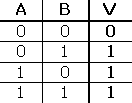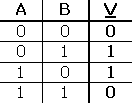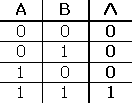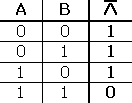Try some of these circuits
or click squares of the grid to construct your own.
A simple clock or click squares of the grid to construct your own.
A frequency halver
A diode
A NOT gate
An OR gate
An XOR gate
An AND gate
A NAND gate
Reset
Play
Pause
Step
Time step
0
A clock emits regular impulses without receiving any input.
Clocks can have different frequencies: this one delivers an impuls every 4th time step.
Clocks can have different frequencies: this one delivers an impuls every 4th time step.
A frequency halver just does what it's name says: it only lets pass one out of two signals.
Karl Sherer first published this particular circuit in September 2003.
Karl Sherer first published this particular circuit in September 2003.
A diode blocks a flow of electrons, but only in one direction.
This circuit shows a clock, sending impulses to 2 diodes. The upper one lets the flow pass,the lower one blocks the flow.
This circuit shows a clock, sending impulses to 2 diodes. The upper one lets the flow pass,the lower one blocks the flow.
A NOT gate emits an impulse if there is no impulse on its input.


An OR gate emits an impulse if there is an impulse on one or both of the inputs.


An XOR or exclusive OR gate emits an impulse if there is an impulse on one and only one of the inputs.


An AND gate emits an impulse if there is an impulse on both of its inputs.


A NAND gate is the combination of an AND gate with a NOT gate.


 WireWorld is, just as Conway's Life, a cellular automaton.
It is the brainchild of
WireWorld is, just as Conway's Life, a cellular automaton.
It is the brainchild of